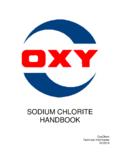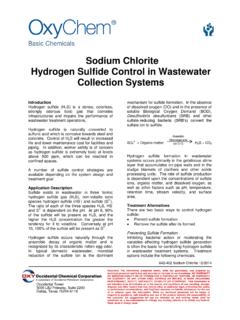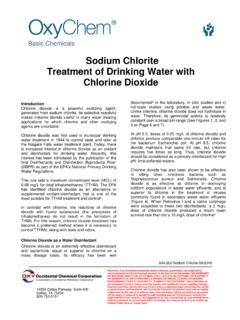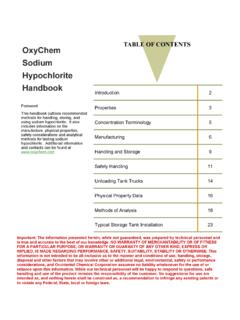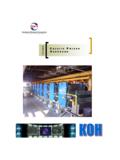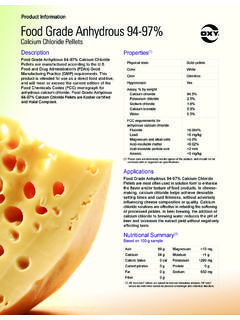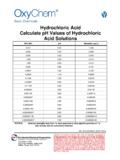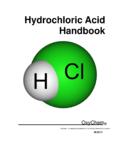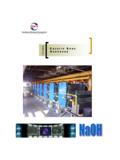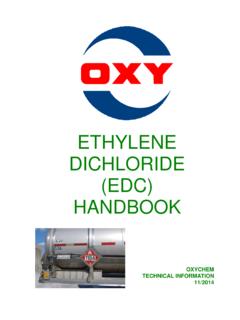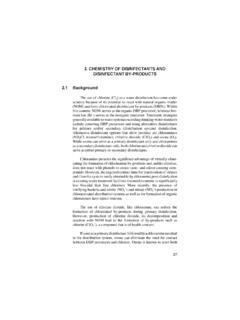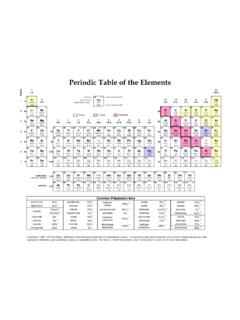Transcription of Sodium Chlorite Chlorine Dioxide ... - Occidental Petroleum
1 Basic Chemicals 600-103 Sodium Chlorite 08/2018 Important: The information presented herein, while not guaranteed, was prepared by technical personnel and is true and accurate to the best of our knowledge. NO WARRANTY OF MERCHANTABILITY OR OF FITNESS FOR A PARTICULAR PURPOSE, OR WARRANTY OR GUARANTY OF ANY OTHER KIND, EXPRESS OR IMPLIED, IS MADE REGARDING PERFORMANCE, SAFETY, SUITABILITY, STABILITY OR OTHERWISE. This information is not intended to be all-inclusive as to the manner and conditions of use, handling, storage, disposal and other factors that may involve other or additional legal, environmental, safety or performance considerations, and Occidental Chemical Corporation assumes no liability whatsoever for the use of or reliance upon this information.
2 While our technical personnel will be happy to respond to questions, safe handling and use of the product remains the responsibility of the customer. No suggestions for use are intended as, and nothing herein shall be construed as, a recommendation to infringe any existing patents or to violate any Federal, State, local or foreign laws. 14555 Dallas Parkway, Suite 400 Dallas, TX 75254 800-752-5151 Sodium Chlorite Chlorine Dioxide Generators Introduction Chlorine Dioxide enjoys many different types of use particularly in water treatment; among these is disinfection, bleaching, and chemical oxidation.
3 The Chlorine Dioxide used in these applications is always generated on-site, usually from Sodium Chlorite , as an aqueous solution. Chlorine Dioxide is a reactive oxidizing gas that is readily soluble in water. Even dilute solutions (10 ppm) of Chlorine Dioxide have a characteristic yellow color. The maximum Chlorine Dioxide concentration typically produced in commercial generators is approximately 4000 ppm. This is to minimize the concentration of Chlorine Dioxide gas in equilibrium with the solution. Gas phase Chlorine Dioxide concentrations in excess of 10%, like ozone, can decompose explosively.
4 This is the reason that Chlorine Dioxide must be generated at its point-of-use. This document will cover the chemistry of Chlorine Dioxide generation, generator design and operation requirements, generator safety requirements, features of many Chlorine Dioxide generators presently available in the market. Generation Chemistry While Chlorine Dioxide may be produced from Sodium chlorate (NaClO3), most small-scale generators use Sodium Chlorite (NaClO2) as their precursor chemical. The economic breakpoint between Chlorite and chlorate generation is on the order of tons/day of Chlorine Dioxide .
5 Three feed chemical combinations will be covered: 1) Chlorine - Sodium Chlorite , 2) acid- Sodium hypochlorite- Sodium Chlorite , and 3) acid- Sodium Chlorite . Chlorine - Chlorite This method, the most flexible and efficient method of generating Chlorine Dioxide , generates Chlorine Dioxide in a two step process. First, (equation 1), Chlorine reacts with water to form hypochlorous acid (HOCl) and hydrochloric acid (HCl). These acids react (equation 2) with Sodium Chlorite to form Chlorine Dioxide , water, and Sodium chloride (NaCl). The ratios of Sodium Chlorite and hypochlorous acid ( Chlorine ) must be carefully controlled.
6 Insufficient Chlorine feed will result in a large amount of unreacted Chlorite . Excess Chlorine feed will result in the formation of Sodium chlorate (NaClO3), which is the oxidation product of Chlorine Dioxide . The typical operating conditions and yields for this method of generation are shown in Table 1. (1) Cl2 + H2O HOCl + HCl (2) 2 NaClO2 + HOCl + HCl 2 ClO2 + H2O + 2 NaCl Net: 2 NaClO2 + Cl2 2 ClO2 + 2 NaCl Acid-Hypochlorite- Chlorite This is an alternative to Chlorine - Chlorite generation that is used when Chlorine gas is not available.
7 First (equation 3), Sodium hypochlorite is combined with hydrochloric or other acid to form hypochlorous acid. Sodium Chlorite is then added to this reaction mixture to produce Chlorine Dioxide (equation 4). (3) NaOCl + HCl HOCl + NaCl Basic Chemicals 600-103 Sodium Chlorite 08/2018 Important: The information presented herein, while not guaranteed, was prepared by technical personnel and is true and accurate to the best of our knowledge. NO WARRANTY OF MERCHANTABILITY OR OF FITNESS FOR A PARTICULAR PURPOSE, OR WARRANTY OR GUARANTY OF ANY OTHER KIND, EXPRESS OR IMPLIED, IS MADE REGARDING PERFORMANCE, SAFETY, SUITABILITY, STABILITY OR OTHERWISE.
8 This information is not intended to be all-inclusive as to the manner and conditions of use, handling, storage, disposal and other factors that may involve other or additional legal, environmental, safety or performance considerations, and Occidental Chemical Corporation assumes no liability whatsoever for the use of or reliance upon this information. While our technical personnel will be happy to respond to questions, safe handling and use of the product remains the responsibility of the customer. No suggestions for use are intended as, and nothing herein shall be construed as, a recommendation to infringe any existing patents or to violate any Federal, State, local or foreign laws.
9 14555 Dallas Parkway, Suite 400 Dallas, TX 75254 800-752-5151 (4) NaClO2 + HOCl + HCl 2 ClO2 + H2O + 2 NaCl Net: 2 NaClO2 + NaOCl + 2 HCl 2 ClO2 + H2O + 3 NaCl Since equations 2 and 4 are identical, the Chlorine Dioxide generation step is the same. Consequently, the typical operating conditions, yield, and purity for this method of generation are the same as for Chlorine - Chlorite generation. This method also shares the requirement of carefully balancing Sodium Chlorite and hypochlorous acid feeds, which is made more difficult by poor storage characteristics (rapid degradation) of Sodium hypochlorite solutions.
10 The typical operating conditions, and yields for this method of generation are shown in Table 1. Table 1 Minimum Maximum NaClO2 (ppm) 1,340 5,360 HOCl (ppm as Cl2) 526 2,100 pH ClO2, theory (ppm) 1,000 4,000 ClO2, actual (ppm) 950 3,800 Acid- Chlorite Acid- Chlorite is the simplest and easiest to operate generation chemistry. This is a consequence of the use of only two feeds and its simple reaction chemistry (equation 5). Instead of having to balance the amounts of Sodium Chlorite and hypochlorous acid, one merely has to provide sufficient hydrochloric acid.
